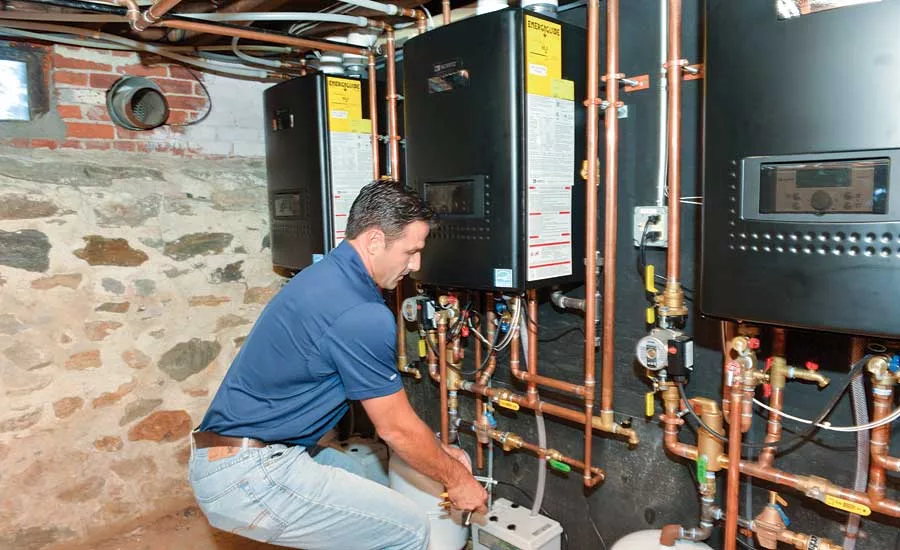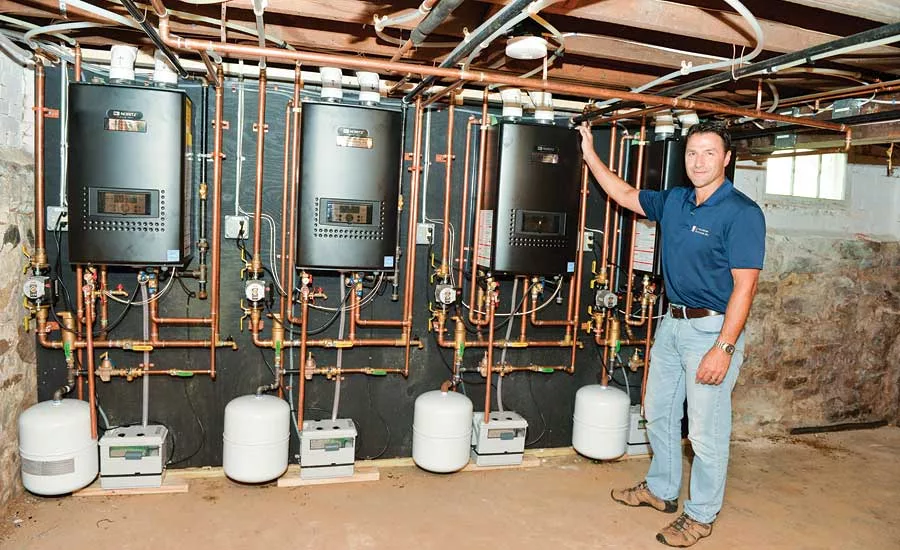Contractor replaces cast-iron boilers with new technologies
Contractor looks to the future of hydronics

Victor Waskiewicz, president of JV Mechanical Contractors, works on installing Noritz’s CB Combi at a multifamily application in Massachusetts. The unit doubles as an energy-efficient boiler and tankless water heater. Photo credit: Frank Monkiewicz

Victor Waskiewicz, president of JV Mechanical Contractors, stands near four installed Noritz CB Combi units at a multifamily application in Massachusetts. Photo credit: Frank Monkiewicz
Some professionals prefer the reliability of conventional methods, and for understandable reasons: They want the install to go quickly and smoothly the first time. But others operate on the forefront of innovation, constantly seeking to apply the latest solutions in an effort to deliver greater value to their customers.
JV Mechanical Contractors, owned by Joe and Victor Waskiewicz, falls into the latter category. Founded in 1987, the father-and-son team does roughly 60% residential work, with the remaining 40% divided between commercial and industrial projects.
One of the Webster, Mass.-based firm’s distinguishing qualities is its willingness to adopt new technologies years — and, in some cases, decades — before anyone else.
“My father, Joe, has always been interested in European hydronic heating technology, even as early as the 1970s and 1980s, when he had the opportunity to travel there and work with such companies like Viessmann and Buderus,” JV Mechanical President Victor Waskiewicz says. Perhaps the most striking example of this firm’s progressive mindset is that it completed its first tankless water heater installation in the early 1990s, roughly a full decade before the technology began making measurable inroads in the U.S.
'Some proactive consumers have already heard of combination boilers, but many have not, and it’s incumbent upon me to inform them of the possible space and energy savings these units offer.'
JV Mechanical is continuing this track record through regular installations of the new 95% AFUE combination boiler/tankless water heater (CB Combi) from Noritz America. Although the product debuted in January 2016, JV Mechanical had already installed 15 units by the end of July 2016.
“We really like this product for the energy and space savings it affords, as well as the exceptional state rebate qualifications,” Waskiewicz says. “The primary benefit that draws customers to the combination boiler and water heater is the energy efficiency. When I explain that its outdoor reset control monitors the temperature to adjust performance, and that it doesn’t have a tank that stores unnecessary hot water, customers understand the savings it can bring. Added to that is a great Massachusetts state energy rebate of $1,600 that applies to those who install a combination boiler/condensing water heater with a 95% AFUE or higher.”
Furthermore, the CB Combi is both comparatively small (17.3 by 28.7 by 14.8 inches) and wall-mounted, allowing it to fit into tight areas of the home.
“People are so accustomed to having separate water heaters and boilers that they are intrigued by the space savings this compact, integrated unit can provide,” Waskiewicz says.
Practical applications
A four-unit multifamily building was undergoing a total remodel, and the owners wanted a plumbing and heating solution superior to the existing cast iron boilers with attached indirect water heaters.
JV Mechanical recommended the CB Combi for energy savings and installed four units, one per residence, to supply baseboard heating systems and separate hot water zones. In addition to the space savings in the basement, the homeowner can take advantage of Massachusetts’ generous state energy rebates — the four units translated into $6,400 in rebates.
Another of JV Mechanical’s projects involved a Connecticut resident who was adding a two-story addition to his home and needed a new source of hot water and space heat. Once again, the CB Combi was the planned solution that would serve a radiant heat slab on the first floor and baseboard heating on the second.
JV Mechanical was also called to a split-level home, where the owner was looking to replace an old cast iron boiler. The boiler was in a room that also contained a laundry, sink, and toilet, making for extremely tight conditions. JV Mechanical installed a propane-fired CB Combi without issue, and the customer was pleased that it was completely off the floor and allowed room for other furnishings.
JV Mechanical, true to its reputation, was already installing combination boilers 10 years ago, long before most other contractors.
“Those early combination boilers lacked the integration of the CB Combi,” Waskiewicz says. “They had an add-on for domestic hot water. I like the new CB Combi because everything is there in one compact package.”
Waskiewicz anticipates many future combination boiler installations and plans to continue educating consumers about the technology.
“Some proactive consumers have already heard of combination boilers, but many have not, and it’s incumbent upon me to inform them of the possible space and energy savings these units offer,” he points out. “As time goes on, I am confident that more and more contractors and consumers will realize the significant benefits they provide.”
This article was originally titled “Contractor looks to the future of hydronics” in the April 2017 print edition of Plumbing & Mechanical.
Looking for a reprint of this article?
From high-res PDFs to custom plaques, order your copy today!





